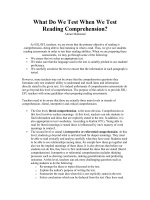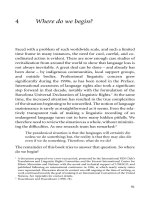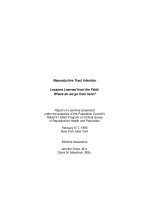Where do we begin
Bạn đang xem bản rút gọn của tài liệu. Xem và tải ngay bản đầy đủ của tài liệu tại đây (212.38 KB, 36 trang )
4 Where do we begin?
Faced with a problem of such worldwide scale, and such a limited
time frame in many instances, the need for cool, careful, and co-
ordinated action is evident. There are now enough case studies of
revitalization from around the world to show that language loss is
not always inevitable. A great deal can be done – and already has
been done – by indigenous communities, local support groups,
and outside bodies. Professional linguistic concern grew
significantly during the 1990s, as has been noted in the Preface.
International awareness of language rights also took a significant
step forward in that decade, notably with the formulation of the
Barcelona Universal Declaration of Linguistic Rights.
1
At the same
time, the increased attention has resulted in the true complexities
of the situation beginning to be unravelled. The notion of language
maintenance is rarely as straightforward as it seems. Even the rela-
tively transparent task of making a linguistic recording of an
endangered language turns out to have many hidden pitfalls. We
therefore need to review the situation as a whole, without minimiz-
ing the difficulties. As one research team has remarked:
2
The paradoxical situation is that the languages will certainly die
unless we do something; but, the reality is that they may also die
even if we do something. Therefore, what do we do?
The remainder of this book tries to answer that question. So where
do we begin?
91
1
A document prepared over a two-year period, promoted by the International PEN Club’s
Translations and Linguistic Rights Committee and the Escarré International Centre for
Ethnic Minorities and Nations, with the moral and technical support of UNESCO, and
published following an international conference in 1996, at which nearly ninety states
were represented. Discussion about its content was still ongoing at the time of writing, as
work continued towards the goal of making it an International Convention of the United
Nations. See Appendix for contact details.
2
Dauenhauer and Dauenhauer (1998: 78).
Establishing the top priorities
The top priority, it would appear, is information gathering.
Although there may be 3,000 or more languages at risk, it is plain
from the earlier chapters that they are not all in the same state of
endangerment. Some are in their final stages now; some have a
great deal of life left in them. Given that time, personnel, and
resources are limited, it is crucial to establish what the really urgent
cases are. That was the chief motivation for the growth, during the
1990s, of the various organizations concerned with endangered
languages (see Appendix), and in particular – as its name suggests
– of the International Clearing House for Endangered Languages
in Tokyo. Fact-finding and prioritization are the immediate needs.
A typical statement from one of the national organizations makes
the same point: ‘the first step in language rescue must be an infor-
mative assessment of a language’s current situation’.
3
And the
editors of a recent collection of essays concur: ‘Only with detailed
and comprehensive data on language vitality is long-term predic-
tion of the global linguistic picture a real possibility.’
4
But information gathering does not exist in a vacuum. What
kind of information is to be gathered? As we have seen in chapter
3, facts about the numbers of speakers are only one of the things
we need to know. Just as important are facts about the context in
which the speakers live, and facts about the attitudes displayed –
both by the speakers themselves and by the larger community of
which they are a part. The relevant interest is in linguistic vitality,
and the possibility of revitalization, so assessments need to take
into account facts about speaker fluency, accuracy, and age levels
in order to arrive at a proper evaluation of the likelihood of conti-
nuity. Indeed, just how many different kinds of relevant facts are
there? What is the difference between an ‘informative’ and an
‘uninformative’ assessment? Plainly, we also need a theoretical
framework to orientate the fact-finding, and to provide guidelines
92
3
Ostler (1997: 5).
4
Grenoble and Whaley (1998a: viii). For an example of a detailed questionnaire approach
to fact-finding, see Mikhalchenko (1998).
about assessment and diagnosis. Such a framework would yield
models which could identify and inter-relate the relevant variables
involved in endangerment, and these models would generate
empirical hypotheses about such matters as rate of decline or stages
in revival. It is already evident that there can be no such thing as a
unified intervention procedure, given that there are so many kinds
of endangerment, and so many possible ways of helping. Different
communities, as we have seen, have different kinds of attitudes and
aspirations in relation to their language. A typological statement
may be all that is achievable in the immediate future, therefore,
identifying the similarities and differences between endangered sit-
uations; but even to reach that point, we need a theoretical frame-
work which has achieved some degree of consensus. It is no good
postponing this step until ‘we have all the facts’. We shall never
have all the facts.
As I write, no such framework exists. Studies of endangered lan-
guages are at a stage where they use widely different frames of ref-
erence and terminology. Even the subject as a whole has no agreed
name.
5
Terms such as obsolescent, moribund, and endangered are
employed in a variety of senses. The people affected are described
differently (e.g. terminal speakers, semi-speakers). The widely
encountered metaphor of critical mass (of speakers needed to
maintain a language) has not been operationalized. Lists of causa-
tive factors (such as the one I compiled myself in chapter 3) are
eclectic and impressionistic, well motivated by individual case
studies, but lacking in generality. Enough studies have now been
carried out, from a sufficiently wide range of places, for the scale of
the problem to be appreciated. A great deal of perceptive analysis
has taken place, and the urgency of the need has prompted many
ad hoc proposals about ways of improving individual endangered
situations. But without a general framework, the opportunities for
cross-fertilization of thought are limited. At grass-roots level, there
must be an enormous amount of ‘rediscovering the wheel’ going
on around the world, as researchers and community advisers,
Where do we begin? 93
5
Perilinguistics was proposed by Matisoff (1991: 201, 224). Personally, I prefer the more
dynamic resonance of preventive linguistics (cf. p. 112).
uncertain whether other initiatives and experiences apply to them,
promote activities of their own devising. In a climate of urgency, at
times almost of panic, it is understandable to see a philosophy of
‘anything is better than nothing’ so widespread. But we know from
other fields, such as speech therapy and foreign language teaching,
that a policy of ‘diving in’, or of reacting only to the most apparent
needs, can produce results that are short-term and inefficient. In a
field where time is of the essence, and money very short, the need
to keep some level of theoretical enquiry operating alongside the
pressing demands of empirical work is therefore essential. This is
also a top priority.
Some progress has been made since Einar Haugen’s largely
ignored call for a ‘typology of ecological classification’, which
would ‘tell us something about where the language stands and
where it is going in comparison with the other languages of the
world’,
6
but most of the work has been in relation to languages in
general, or to minority languages, regardless of whether they are
endangered or not. It is possible, of course, to adapt proposals in
this direction, and some efforts have been made to do this. For
example, a typological framework devised by John Edwards for
minority languages recognizes eleven relevant factors, each of
which is applied to languages, their speakers, and the settings in
which they speak: demographic, sociological, linguistic, psycholog-
ical, historical, political, geographical, educational, religious, eco-
nomic, and technological.
7
Lenore Grenoble and Lindsay Whaley,
focusing on endangered languages, suggest literacy as an additional
factor, and propose a hierarchical organization of all factors, giving
the economically based variables priority. They also extend the
model to include various levels of external influenceuponalan-
guage – local, regional, national, and extra-national.
8
This is exactly
how a typological framework develops, through a process of intel-
lectual reflection in the light of case studies. Certain factors, notably
economic power, social status, and density of speakers, are going to
94
6
Haugen (1971: 25). This title was given to his collection of essays, The ecology of language
(Haugen, 1972). See also p. 32 above.
7
Edwards (1992).
8
Grenoble and Whaley (1998b).
rank highly in most situations. But establishing priorities takes
time. Moreover, some of the issues are notoriously difficult to
explore, such as assessing a person’s level of comprehension ability,
or determining a speaker’s proficiency in controlling the range of
stylistic features in a language.
Fact-finding and the development of a theoretical perspective
should be two sides of the same coin. But for either to proceed, there
have to be coins. What the coins do is pay for the job to be done. It is
important, therefore, to have a sense of the costs involved – or at least
of their order of magnitude. As far as a first encounter with a lan-
guage is concerned, a thumbnail calculation provided by the
Foundation for Endangered Languages
9
suggested that £35,000 (c.
$56,000) per language would provide a basic (A-level) grammar and
dictionary, assuming two years of work by one linguist. Dixon esti-
mates that, to do a good job, we need to allow a linguist three years,
and there would then not be much change from $200,000 (c.
£125,000) after taking into account a salary, fees for indigenous lan-
guage consultants, travel, equipment, accommodation, publication
of the findings, and the provision of basic facilities for revitaliza-
tion.
10
Gerdts takes an even broader view, anticipating in-depth
studies, the development of an audio-visual archive, and a wider
range of publications and teaching materials: she concludes that the
estimate per language would be more like fifteen years and $2 million
(c. £1.25 million).
11
Conditions vary so much that it is difficult to
generalize, but a figure of £40,000 (c. $64,000) a year per language
cannot be far from the truth. If we devoted that amount of effort over
three years for each of the 3,000 cases referred to in chapter 1, we
would be talking about some £360 million ($575 million). That may
seem like a lot of money; but, to put it in perspective, it is equivalent
to just over one day’s OPEC oil revenues (in an average year).
Fund-raising, whether carried out at international, national,
regional, or local levels, is therefore another top priority. And
funds do not come unless people are aware of the urgency of a need
and convinced of its desirability (see chapter 2). Fostering a climate
Where do we begin? 95
9
Editorial, in Iatiku 1. 1.
10
Dixon (1997: 138).
11
Gerdts (1998: 14).
of opinion thus has to be carried on in parallel with the above two
activities, which means a wide range of public relations and polit-
ical initiatives. Endangered languages have to be given a higher
profile with the public, which means making maximum use of the
media, and devising appropriate publicity campaigns. Although
many areas of world concern have attracted public support by
being assigned official ‘days’, ‘weeks’, ‘months’, and ‘years’ – for
example, 1997 was the international year of the coral reef, 1998 the
international year of the ocean – lost, endangered, or dying lan-
guages have not been given such attention.
12
Perhaps the lack of awareness of endangered languages is simply
another manifestation of the general lack of awareness about lan-
guage among the public at large. Certainly, this is not the first time
that language professionals have bemoaned the apparent absence
of public interest in their field, complaining about poor levels of
investment or resources, or pointing to the relatively low salaries
found in linguistic specialisms. Speech and language therapy (or
pathology) is one such field, where very similar arguments to those
currently being reviewed in relation to language endangerment
have been loudly and repeatedly made since the 1970s.
13
It is
perhaps the climate of the time. All language professionals have
suffered the consequences of a general malaise about language
study which has long been present among the general public – an
inevitable consequence (in my view) of two centuries of language
teaching in which prescriptivism and purism produced a mental-
ity suspicious of diversity, variation, and change, and a terminol-
ogy whose Latinate origins crushed the spontaneous interest in
language of most of those who came into contact with it.
14
Not that
96
12
The European Bureau of Lesser Used Languages did however organize the first European
Language Day, on 12 April 1997.
13
See, for example, some of the arguments in Crystal (1982).
14
Two specific examples of the consequences, from my own experience. I once had the
opportunity to ask the purchasing manager of a major UK national book-chain why
none of a paperback series on linguistics was available on its shelves, and was told that
language was too difficult for the average purchaser; when I asked him what he meant,
he talked about his bad memories of traditional grammar in school. I have also encoun-
tered the same response on several occasions (from different broadcasting companies)
when trying to establish why there has never been a blockbuster series on linguistics on
either radio or television.
the task of teaching about language is easy. On the contrary: it has
always proved extremely difficult to convey the facts about lan-
guage to the public, language being by its nature so abstract and
complex. But there have been enough successful cases of language
presentation through books and broadcasting to demonstrate that
the task can be done; and when it is done, a warmly interested
response is widespread – for most people do have an intuitive curi-
osity about language matters (at least, in their own language),
whether it be the history of words, the character of local accents
and dialects, or the origins of personal names and place names.
Fortunately, there are clear signs that the climate is now changing,
in the form of new language curricula in several parts of the world;
the excitement and fascination of language study has been well
captured by new generations of teachers.
15
But of course there is an
inevitable time lag before the students who will benefit from this
teaching reach sufficiently influential positions in society for their
views to make a difference. As a consequence, the promotion of a
fresh public attitude towards language in general (and towards
endangered languages in particular) remains a current priority.
Several linguists engaged in this work have seen the need to
become engaged with politicians and public bodies, and to get
them thinking about language policies and practices. One puts it
this way:
16
There are many ways to work towards slowing the erosion of
linguistic diversity and one task is to develop and diversify ways
that this might happen, to engage with people who are not
professional linguists and to be open to innovative ways of
thinking and acting.
The problem varies among countries. In former colonialist
nations, in particular, linguists have to cope with a general inexpe-
rience of bilingualism, which makes it more difficult than it should
be to get the message across. The greater the amount of foreign lan-
guage learning in a country, whether in the home or in school, the
easier this aspect of the task becomes. The chief aim is to develop
Where do we begin? 97
15
See the discussions in Brumfit (1995), Sealey (1996), Crystal (1999).
16
Rhydwen (1998: 104).
in people a sense of the value of a language, and of what is lost
when a language dies – the kind of arguments reviewed in chapter
2. There is an urgent need for memorable ways of talking, to
capture what is involved: we have to develop ear-catching meta-
phors – language as a ‘national treasure’, perhaps, or as a ‘cause for
celebration’, or a ‘natural resource’. The two-way relationship with
ecology needs to be developed: not only does an ecological frame
of reference enter into language discussion; language issues need to
become part of general ecological thinking.
17
Conferences and
campaigns about the environment need to include language as part
of their remit. A general concern about conservation is already out
there, as has been seen in the many national ecological campaigns
about climate, biology, and heritage; it now needs to be focused on
language. This was the chief motivation leading to the establish-
ment of one of the new pressure groups of the 1990s, Terralingua
(see Appendix), one of whose goals is:
To illuminate the connections between cultural and biological
diversity by establishing working relationships with
scientific/professional organizations and individuals who are
interested in preserving cultural diversity (such as linguists,
educators, anthropologists, ethnologists, cultural workers, native
advocates, cultural geographers, sociologists, and so on) and
those who are interested in preserving biological diversity (such as
biologists, botanists, ecologists, zoologists, physical geographers,
ethnobiologists, ethnoecologists, conservationists, environmental
advocates, natural resource managers, and so on), thus promoting
the joint preservation and perpetuation of cultural and biological
diversity.
In countries where a language focus is already present, such as
in Wales or Quebec, where linguistic issues are daily news, there is
still a need for action. Awareness and concern has to be fostered
about the problem as it exists worldwide, because all minority and
98
17
The first joint meeting on the loss of cultural and biological diversity, with a focus on lan-
guage, took place at the University of California, Berkeley, in 1996: ‘Endangered
Languages, Endangered Knowledge, Endangered Environments’. See the report in Iatiku
4. 14–16. The call for an ecological perspective for language goes back a generation, at
least to Haugen’s unjustly neglected paper (1971: 19): ‘Language ecology may be defined
as the study of interactions between any given language and its environment . . . Language
exists only in the minds of its users, and it only functions in relating these users to one
another and to nature, i.e. their social and natural environment.’
endangered languages will benefit from a universal consciousness-
raising about linguistic diversity. Language supporters everywhere
are on the same side – but they need to realize this, and devise ways
of showing it and capitalizing on it.
18
Although there are now
organizations for professionals to keep in touch with each other,
only limited progress has yet been made in providing mechanisms
to foster international collaboration at grass-roots level. Some
parts of the world have come to be relatively well served: Europe,
for example, has the European Bureau of Lesser Used Languages,
established in 1982, with its regular information bulletin, Contact
(see Appendix). There have also been occasional publications in
which people from different nations tell each other about the lan-
guage situation in their own country,
19
and there is a growing use
being made of the Internet for this purpose. But on the whole,
apart from a minority of politicians, language activists, and profes-
sional linguists, people in one part of the world are largely unaware
of what is going on in other places. The need for a global perspec-
tive on language endangerment is therefore urgent, and its impor-
tance cannot be overestimated. It is not simply a question of people
learning from each other’s situations and solutions. People need
inspiration and encouragement – especially when confronting
recalcitrant governments; and awareness that they are not alone,
and that there are channels which can be used to elicit international
co-operation, can make a lot of difference.
Within a country, people do not change their minds, or develop
positive attitudes about endangered languages, just by being given
information; the arguments need to capture their emotions. In
particular, art forms need to be brought to bear on the issue. There
are still far too few poems, plays, novels, and other genres in which
the notion of language is the theme.
20
Nor should music, painting,
sculpture, dance, and other forms of artistic expression be left out
Where do we begin? 99
18
This may in fact be an unrealistic expectation. Quite naturally, an indigenous commu-
nity is preoccupied with its own situation, and unlikely to be much interested in endan-
gered language situations elsewhere in the world. The levels of mutual interest and
activism achieved in Europe, Australia, and the USA in recent years are not typical of
most places, and even there they tend to have a regional focus.
19
Iorwerth (1995).
20
Examples include Harold Pinter’s play, Mountain language (1988); Margaret Atwood’s
poem, ‘Marsh languages’, in Morning in the burned house (1995); David Malouf’s short
story, ‘The only speaker of his tongue’ (1985); and my own play, Living on (1998).
of consideration. To take just one example from one place in one
year: a piece of sculpture in New York in 1997–8.
21
There is a
report, probably apocryphal, of an event which took place when
the explorer Alexander von Humboldt was searching for the source
of the Orinoco, in South America, in 1801. He met some Carib
Indians who had recently exterminated a neighbouring tribe (pos-
sibly a Maypuré group) and captured some of their domesticated
parrots. The parrots still spoke words of the now extinct language,
and von Humboldt – so the story goes – was able to transcribe
some of them. Having heard this story, Rachel Berwick, professor
of sculpture at Yale University, saw its intriguing possibilities, and
constructed an artwork based upon it: she designed a special enclo-
sure in which were displayed two Amazon parrots who had been
trained to speak some words from Maypuré, and this was then
exhibited at various venues in 1997–8. By all accounts, the venture
focused the mind wonderfully. So, if sculpture, why not – music?
Is there yet a symphony for dying languages? Has there been a pop
concert in support of Language Aid? It would be good to see some
of these initiatives in the opening decades of the new millennium.
Bottom-up initiatives are a top priority too, for they help to
form the ground swell of public opinion which can make govern-
ments act. A considerable amount of top-down action has already
taken place, at least in those regions where minority-language sup-
porters have been most active. But in many parts of the world,
vociferous activism on behalf of minority languages is absent or
suppressed. Governments may be indifferent or antagonistic (see
chapter 3). Statistics about speakers can be manipulated or dis-
torted. And even in the most active regions, the concept of endan-
germent is often not given the attention it should be.
22
In Europe,
the focus has tended to be more on language rights than on endan-
germent. Also, there is still some way to go before declarations con-
cerning language issues are given global status. In the meantime,
100
21
Reviewed in Holt (1998).
22
In 1999, for example, I found myself in correspondence with the British Foreign Office
over a foreign affairs committee report on the implementation of a policy document on
human rights which referred to every conceivable category of right – except language.
the need for political lobbying and effective agitation remains
strong.
The notion of ‘top-down’ applies not only at international level
but also within individual countries and in localized regions. The
development of appropriate structures at national level is a prior-
ity, especially in parts of the world which have large numbers of
indigenous languages and no real history of study or concern. One
of the most promising signs during the last few years, in fact, has
been the establishment of new academic centres within a number
of countries, demonstrating by their existence a fresh sense of lan-
guage values; examples include the Colombian Centre for Study of
Indigenous Languages at Bogotá, the Museu Paraense Emîlio
Goeldi at Belém, Brazil, the Academy of Mayan Languages in
Guatemala, the Hokkaido Ainu Culture Research Center in
Sapporo, and the Center for Endangered Languages at Jos, Nigeria.
These centres carry out several roles simultaneously: in addition to
fact-finding and language description, they provide a channel of
communication between local community and government, and a
mechanism for directing energies, funds, and revitalization activ-
ities. They give indigenous languages an institutionalized presence,
and thus prestige; for without prestige, and the power which this
brings, no language movement can succeed. Some of the
difficulties which such centres encounter will be reviewed below.
Several priorities have been identified in this section, and it seems
impossible to choose between them. Nor should it be necessary to
choose. There is no reason why these various activities should not
continue simultaneously, in a kind of ‘parallel processing’. If the
metaphor we have to live by is one of battle, then we need to be
active on several fronts at once. And we need to be prepared for a
long campaign. There is no opportunity to be complacent, as polit-
ical attitudes can change overnight, with a consequent loss of
funding or a restatement of priorities. Because bilingual education
is expensive, it is under constant threat. Conflicting ideologies
(such as a policy which supports anti-immigration or English as an
official language) may obtain grass-roots support which suddenly
Where do we begin? 101
endangers a project previously thought to be safe. Throughout the
1990s, there were several reports of language support programmes
becoming endangered through budgetary cuts. The Hawaiian
Language Program was one such, necessitating an appeal for inter-
national support in 1995. Another was in Australia, at the end of
1998, when the Northern Territory government announced plans
to phase out bilingual education for its Aboriginal communities,
replacing this by English-teaching programmes.
23
For real progress in an endangered language, it is clear that
several elements need to be in place. There needs to be an indige-
nous community interested in obtaining help, and with a positive
attitude towards language rescue. There needs to be a positive
political climate, committed to the preservation of ethnic identity
and cultural rights, prepared to put some money where its princi-
ples are, and where the political implications of language mainte-
nance have been thought through. And there need to be
professionals available to help with the tasks of language selection,
recording, analysis, and teaching. I shall now look in more detail at
what each of these elements involves.
Fostering positive community attitudes
Negative attitudes towards one’s own language are surprisingly
common (see chapter 3). Language-aware and well-intentioned
Westerners are sometimes shocked to encounter a community
whose members do not care about the survival of its language, or
who are antipathetic about its maintenance. How should we react,
faced with such an attitude? Should we take the view that the deci-
sion is theirs alone, that we have no right to interfere in a situation
about which, in the nature of things, we can have only a limited
understanding? Or should we adopt a broader outlook, allowing
our knowledge of the long-term linguistic issues involved to justify
continued interest in their language and warrant attempts to
102
23
See the reports in Iatiku 1 (1995), 3; Ogmios 10 (1998), 8.
change their minds? This has been a hotly debated question,
24
raising issues of great complexity and sensitivity. It is essential to
‘take a view’ about it, for it will influence decision-making about
the provision of support. Given that there are so many languages
in need of help, one argument goes, then the limited resources
should be directed towards those communities whose members are
interested in preservation; if other communities want to commit
linguistic suicide, that is their own business, and we should not
waste our time, energy, and money trying to persuade them other-
wise.
The first thing we should recognize is that, in real life, the issues
are not so black-and-white. Within a community, attitudes will be
mixed: some members will be in favour of preservation, others will
be against it. There will be pride, apathy, guilt, denial, regret, and
many other emotions. Moreover, the reasons for support and
opposition will be mixed. One family may be particularly proud of
its tradition of ethnic identity; another family may not. One family
may have gained a great deal economically from shifting to the new
language; another family may not. One person may view an ances-
tral language as useless and irrelevant; another may not use func-
tional arguments at all, seeing it rather as a source of spiritual or
psychological strength. An early goal, in assessing an endangered
situation, accordingly, is to understand the reason for any negative
attitudes encountered, to determine how typical they are in the
community as a whole, and to evaluate the impact of the attitudes
on the community’s way of life, in both the short and the long term.
Some attitudes, it has to be accepted, are negative for the best of
reasons. It is axiomatic that physical wellbeing is a top priority:
there is no point in going on to people about language if they are
too ill to speak or too hungry to listen. If food, welfare, and work
are lacking, then it is only to be expected that they will direct their
energies to ways of increasing resources and fostering economic
growth. The same applies if military conflict, political oppression,
Where do we begin? 103
24
A defence of the former view was presented in a discussion note by Ladefoged (1992).
This in turn was responded to by Dorian (1993). Several of the arguments are alluded to
below.
or civil disturbance threaten their daily safety and survival.
Matthew McDaniel is one field worker who has made this point, in
relation to the Akha of Thailand; his language is emotive and dra-
matic, but it only reflects a reality:
25
what these people need is plain old help, so they can keep their
babies alive so that the babies will live long enough to learn the
language . . . One struggles to find out why the infants die so fast,
before you could get back with medicine; there is no one to do
autopsies to find out the actual cause of the death, so one is still in
the dark and it happens like clockwork, and you wonder whether
it matters at all if you get the language written into a dictionary
when you have to look at that baby girl of three months dead on
the floor of the hut and feel so damn helpless over and over again.
Unless the people in the west open up their wallets and time to
give these people real help, as long as the western economic model
rolls on consuming everything in sight broken down into
consumption units, I think there is no hope at all and all of this
work becomes foolishness.
Mari Rhydwen makes a similar point:
26
When basic needs for shelter, food, safety and health are unmet,
even thinking about language maintenance or revival seems like
an irrelevant luxury.
Such observations seem almost unanswerable. And yet, it is a fact
of life that circumstances, priorities, and goals all change with
time. If the development programmes fostered by international
organizations are at all successful, then the hope is that there will
come a time when, healthy and well-fed, people will have the time
and energy to devote to quality, as opposed to quantity, of life. At
that point, they will look to revive their cultural traditions and to
affirm their cultural identity. That is when they will look for their
language. And if their language has gone, unrecorded and unre-
membered, there is no way in which they can get it back. By con-
trast, if a modicum of effort has been devoted to language
preservation, even in the most difficult of economic circumstances,
at least these people have kept their options open. They can make
104
25
McDaniel (1998: 15).
26
Rhydwen (1998:105).









